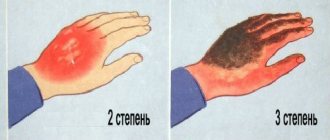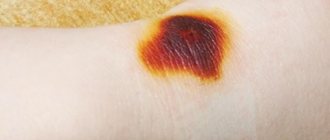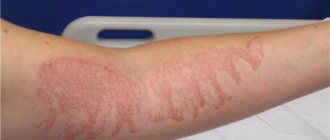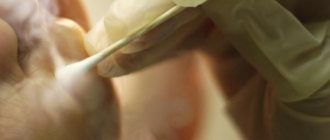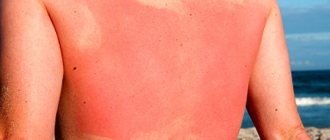Compress with Dimexide
It must be remembered that the drug is never used in its pure form, otherwise it is easy to get a severe burn. To make a Dimexide solution for a compress, be sure to use rubber gloves and not overexpose it to the affected area. You cannot rub the drug into the skin, even diluted, since the resulting chemical burn is difficult to cure later. A compress from Dimexide should be made only with white gauze or a bandage. If colored fabric is used, the medicine will draw the dye under the skin, and the person will experience a serious allergic reaction.
In gynecology
The drug is used in gynecological practice as an adjuvant. Applications with Dimexide are applied during rehabilitation for cancer after radiation therapy. The solution is also used for fungal infections and other infectious and inflammatory diseases of the external genitalia. Tampons with Dimexide are excellent for cervical erosion and thrush. For these diseases, the solution must be diluted in a ratio of 1 to 5 parts of water. It is useful to add aloe juice or lidase to compresses with Dimexide.
For acne
The healing properties of Dimethyl sulfoxide allow you to get rid of blackheads, acne and other skin irritations. To make lotions with Dimexide, you need to dilute the drug with water in a ratio of 1:4, then soak gauze and apply for half an hour. Place a piece of polyethylene on top of the compress and cover with linen cloth. Another method of use is face masks. They are easy to prepare by adding an equal volume of tea tree oil to an aqueous Dimexide solution (10%). Apply directly to pimples and leave overnight.
For joints
For effective treatment, a compress with Dimexide on the joints is made by combining the concentrate with other drugs. It is effective for arthrosis to dilute Dimethyl sulfoxide in equal parts with analgin (in ampoules) and water. After just 5 minutes of applying this mixture, the pain disappears. For thrombophlebitis, doctors advise applying a compress of Dimexide to the joint with heparin (ointment). For arthritis, a water compress in equal proportions with Diclofenac (in ampoules) is effective.
Against cough
Rubbing and compresses with dimethyl sulfoxide solution have long been used to treat throat and cough in adults and children. Inflamed airways need to be warmed from the outside and relieve internal symptoms, and the drug copes with this task perfectly. When coughing, dimexide should be diluted with warm water in a ratio of 1:4, then a compress should be made according to the usual scheme. It is applied for 40 minutes exclusively to the chest, avoiding the heart area.
For bruises
Dimethyl sulfoxide solution is widely used for sprains and injuries. The compress helps hematomas dissolve faster, relieves tissue swelling and inflammation. Dimexide for bruises can be used at 50%, if the integrity of the tissue is not compromised. When the wound is open, apply a 10-20% solution. In case of sprained ligaments, if very severe pain occurs, the doctor, in addition to pain-relieving compresses, may additionally prescribe anti-inflammatory drugs that are administered intramuscularly.
For gout
A rheumatic disease is characterized by very strong symptoms. The pain is usually localized in the joints of the lower extremities, less often in the arms. A compress with Dimexide is almost always used for gout, because the medicine provides quick relief of pain and stops the inflammatory process. The drug is mixed 1:1 with warm water. The application is applied to the affected area for 30 minutes. The duration of the application can last from 10 days to 3 months.
Treatment of felon with Dimexide
Purulent inflammation of the soft tissues of the finger is called felon. At the initial stage of the disease, conservative treatment is possible. If a purulent process has developed, then surgical intervention is required already on the third day. Treatment of panaritium with Dimexide is carried out at the beginning of infection of the finger. To do this, use a 20% alcohol compress, in which Dimethyl sulfoxide is diluted with 70% alcohol or vodka. Apply applications 3 times a day, alternating with warm baths.
Compress for treating child's joints
With its help you can get rid of pain; before using it, you must first apply the ointment to the sore spot, then a compress. This mixture has a deep effect on the joints and will stop the inflammatory process.
Thus, compresses with dimexide are an effective anti-inflammatory agent for treating a child, but despite this, you need to be extremely careful with this drug, as it can cause serious intoxication of the body and burns. Consider all contraindications so as not to harm the child. Do not use a compress with dimexide for small children, it is dangerous for their vital organs. Be sure to consult with your doctor about the dosage and use of the compress.
«>
Description of the product
The active substance of the drug is dimethyl sulfoxide
. The product is available in the form of a concentrate for preparing a solution for external use, a concentrate for preparing a solution, as well as in the form of an ointment and gel.
It is used in the form of lotions or applications and provides:
- anti-inflammatory
– reduces swelling and hyperemia, - local anesthetic
– blocks sensory nerve endings, reducing pain, - fibrinolytic
– dissolves fibrin clots that prevent skin renewal (regeneration), - antiseptic effect
- destroys pathogenic microorganisms.
It is important! Dimexide - used exclusively externally. Taking the drug orally can cause the most severe complications, and even lead to death.
An important property of Dimexide is the ability to penetrate well through the skin and mucous membranes, therefore it is often used in combination with heparin, antibiotics and anti-inflammatory drugs, for better penetration of these medicinal substances to the site of action. Used in the form of lotions or applications to treat inflammatory processes on the skin: the resulting solution is applied to gauze, applied to the affected surface and left for 20-30 minutes, wrapped on top with a cotton cloth and heat-insulating material (cotton wool, woolen scarf, etc.)
Used as lotions or applications
for the treatment of inflammatory processes on the skin: the resulting solution is applied to gauze, applied to the affected surface and left for 20-30 minutes, wrapped on top with cotton cloth and heat-insulating material (cotton wool, woolen scarf, etc.).
Preventive measures
The following simple measures will help avoid burns:
- Do not use Dimexide without doctor's recommendation
. - Do not exceed
the recommended
dose
of Dimexide powder when preparing the solution; stir the concentrated substance thoroughly, as undissolved particles of the drug can cause a burn. - Do not use if you are hypersensitive, or for treating children under 12 years of age.
- Do not rub
the product into the skin. - Do not leave the application for more than 20-30 minutes
.
To check whether there is an allergic reaction to this product, before using it, apply a small amount of solution with a cotton swab to the area of the skin in the area of the elbow.
If there is no skin reaction in the form of rash, itching or redness within two hours, you can use the drug, but be sure to be careful.
Dimethyl sulfoxide (Dimexide) is an anti-inflammatory, analgesic agent used in medicine and cosmetology. The drug is a strong antiseptic and has healing and antimicrobial properties. It is able to penetrate deep into the skin and work effectively at the site of inflammation, therefore it is actively used for compresses.
Properties of Dimexide
Dimexide, forgotten for a whole century after its invention, is actively used due to features that were discovered much later than its creation:
- has a strong anti-inflammatory effect;
- soothes pain not only in the area of application, but also in any other place (blocks the signal to the pain synapses of the brain);
- has an antipyretic effect;
- helps the body produce interferon faster (to fight viruses);
- stimulates the immune system;
- attaches to water cells in the body (hydration process) and with the help of this moves and transports medicinal substances throughout the organs and systems;
- dilates blood vessels;
- makes human skin resistant to frost (prevents rapid freezing and frostbite)
- has a detrimental effect on bacteria and fungus;
- removes free radicals;
- fights against foreign cells of the body (including malignant tumors);
- has a regenerating effect;
- promotes the resorption of blood clots;
- prevents freezing of water in a solution with it (this property is used in organ transplantation for transportation);
- has an accumulating effect even when using a small amount of the product.
How to treat the burn further
In order for the restoration of the skin to go smoothly, without suppuration and scarring, it is important to strictly follow all medical recommendations. Typically, two types of therapy are used
The first is the prescription of medications. The second direction is to use traditional methods.
From medications for chemical burns
, which include burns from dimexide, liquid chlorophyll has proven itself well. This natural preparation, when regularly applied to the burn site 1-2 times a day, accelerates regeneration and cleanses the wound of microorganisms, preventing it from suppuration. Panthenol and olazol, which also have anti-inflammatory and healing effects, have excellent properties.
To further dry the wound surface, you can simultaneously (once a day) use zinc paste. Ointments containing hormonal components, hydrocortisone or prednisolone, should be used only with the permission of a doctor for deep and extensive injuries. Their unauthorized use may cause harm to the patient's health.
With the application of medications to the damaged area of the skin, you can alternate the use of some methods of traditional medicine.
. The most appropriate and effective of them is considered to be ordinary potato starch. To do this, you need to mix it with cool water so that you get a thick paste. It is applied to the burn site in a thin layer and covered with gauze. Frequency: 1 time every other day.
Instead of starch, you can take a cabbage leaf, mash it a little and tie it to the sore spot. This compress is done at night. Applying natural vegetable oil, but in a thin layer, also helps very well. You can take sea buckthorn, lavender, and flaxseed oils, which help restore the deep layers of the skin.
Before using dimexide, be sure to read the instructions. Then the patient will not have to take a long time to treat burns received due to improper use of the product.
Dimexide is an anti-inflammatory analgesic that is used to treat rheumatism, arthritis, inflammatory processes on the skin and a large number of other diseases, since the composition has a number of healing qualities.
It is available in the form of a solution that heals wounds, anesthetizes the skin and reduces the intensity of the inflammatory process. Dimexide is often used as a base for compresses, but you need to be careful with it, since if used incorrectly you can get a burn and various allergic reactions.
Diagnosing a burn injury is not difficult, since it manifests itself in the same way as any other chemical burn, namely, at the site of the injury, the skin turns white and discomfort appears. Based on this, many people are interested in: if you get a burn from Dimexide, what should you do?
Correct dosage of the drug
- For trophic skin ulcers, a thirty percent solution in an amount of 50-100 milliliters is applied to the area of the pathological process twice or thrice a day.
- For pustular skin pathology (boils, carbuncles), a forty percent solution is used.
- For scleroderma - compresses with a forty to fifty percent solution.
- For the purpose of pain relief for pathologies of the structures of the musculoskeletal system, it is worth applying a compress with a twenty percent solution twice a day for 20 minutes.
- When a patient undergoes skin transplantation, a compress with a ten percent solution is applied to the surgical area.
- For deep burns of the skin and soft tissues, bandages with a twenty percent solution are used.
- If the product needs to be used on sensitive areas such as the face and eyelids or for washing purulent cavities with soft tissue abscesses, a dimexide solution with a lower concentration is used - about ten percent.
Dimexide burn
A very popular and popular external remedy, dimexide, is used in the treatment of many diseases for several reasons.
This transparent gel heals wounds, anesthetizes the skin at the site of damage, reduces the intensity of the inflammatory process in it, and accelerates regeneration processes.
It is prescribed not only for bruises and sprains, but also for the treatment of diseases that are localized more deeply, for example, neuralgia, arthritis, radiculitis.
httpv://www.youtube.com/watch?v=embed/rwA8Xc9s8gg
Dimexide freely penetrates the skin, mucous membranes and any biological membranes, delivering with it to the inflammatory focus other medicinal substances necessary in therapy.
This invaluable quality of the external drug, which allows it to be used to treat deep lesions, has another side to the coin.
That is, in case of an overdose or the patient’s individual sensitivity to dimexide, a burn may develop not only on the surface layer of the skin, but also on its deep structures.
What to do immediately after a burn with dimexide
Even with a normal dosage of the product, namely applying it to the skin in a very thin layer, side effects may occur in the form of slight redness of the dermis, itching or mild burning.
If the patient, trying to recover from the disease as quickly as possible, smears a thick layer of gel on the skin area or has an individual intolerance to the components of the drug, then a fairly severe burn is guaranteed.
Almost immediately, a person begins to feel pain and a strong burning sensation at the site of application of dimexide, the skin turns red and itches. Penetrating deeper into the skin, the gel continues to have a negative effect, and ultimately the victim is found to have damage to all layers of the skin, in severe cases with ulcerations.
Only running water for 15–20 minutes can wash away the gel-like substance without any residue, while simultaneously relieving pain and burning.
Do not use towels, napkins or cotton pads to wipe off dimexide, as these rough actions further injure the skin and increase the area of damage.
First aid
To prevent deep damage, if severe burning and painful sensations occur, you should immediately:
- rinse off the medicine with cool running water (rinse for at least 15-20 minutes);
- very carefully blot the skin with a napkin;
- cover the damaged area with a sterile bandage;
- take a pain reliever (Analgin, Ketanov, Ibuprom, Nise) if the pain is severe and does not go away;
- contact a doctor who will determine the extent of the damage and, taking this into account, will advise how to treat the burn.
If you receive a burn from Dimexide, it is prohibited:
- wipe the solution with a towel, cotton pads, napkins (these actions will lead to even greater tissue damage and an increase in the burn area);
- apply ice to the damaged area;
- treat the wound with a solution of potassium permanganate, alcohol tinctures, fatty creams and oils, fermented milk products;
- apply leaves of medicinal plants to the burn;
- use non-sterile materials, cotton wool, to treat the burn;
- cover the damaged area with a plaster;
- apply too tight an antiseptic bandage;
- pierce blisters, remove crusts.
Incorrect actions when providing first aid will aggravate the situation and can cause the development of post-burn complications: purulent inflammation, the formation of scars.
Traditional methods of treatment
A burn with Dimexide belongs to the group of chemical burns. It usually takes several weeks for the damaged area to fully recover. But treatment can be accelerated, and proven folk remedies come to the rescue. These include:
- potato starch
. It is diluted with warm water (boiled) in a ratio of 1:2 - 1 tablespoon of starch and 2 tablespoons of water. Apply the resulting mixture to the burn site;
- fresh cabbage
. A small sheet of it can be applied to the damage. In this case, it is especially effective to use it together with potato starch: first lubricate the burn with starch pulp, then apply a cabbage leaf;
- oils: sea buckthorn or lavender
. You can buy them at the pharmacy and lubricate the burn wound.
At home, only superficial and shallow burns can be treated. In cases where the area of damage begins to fester, swelling, itching or severe pain appears, you should immediately consult a doctor.
What to do?
When faced with unpleasant sensations after using Dimexide, you should first give yourself or a loved one first aid and assess the severity of the injury. Minor redness can be treated at home using available medications. But in case of serious injuries, it is imperative and as soon as possible to contact the trauma department.
If a burn from Dimexide occurs in a child, you need to show the baby to a doctor in any case. Children have thinner and more delicate skin, as well as a smaller area of the epidermis in general, so even minor chemical injuries can be very dangerous for them.
First aid
In case of a burn with Dimexide, the first step is to remove the medicine from the skin. To do this, you need to lower the problem area under running cool water for 10 - 20 minutes. The longer the medicine is on the skin, the longer it takes to wash it off. You should not remove the drug from tissues with improvised means (sponge, bandage or napkin), as this will only penetrate the skin more deeply.
After removing the medicine from the skin, carefully blot the affected area with a soft towel. If necessary, you should apply a loose gauze bandage (if the burn can be injured by clothing or various objects).
How and what to treat next?
In general, treatment of skin after a burn with Dimexide is no different from the treatment of a regular thermal burn. At home can be used:
- Creams or sprays with dexpanthenol (a derivative of vitamin B5) - Bepanten, Panthenol, etc. Such medications soften, nourish and moisturize the skin, in addition, they stimulate the restoration processes of affected areas.
- Balms Rescuer, Guardian, etc. Such medicines contain natural ingredients; they prevent inflammation, help restore the skin and improve its condition after injury.
- Solcoseryl. This is a gel that can be used to treat burns. This medicine remarkably activates regenerative processes and helps avoid scarring.
- Spray Olazol. This medicine contains an antibiotic, an anesthetic component Anestezin, as well as a stimulator of reparative processes - sea buckthorn oil.
- Cream La-Cree. This remedy does a good job of reducing pain and swelling in minor burns; it also has anti-inflammatory properties and helps prevent infection.
You can use medications to treat burns only after providing first aid, making sure that there are no more residues of Dimexide on the skin.
Difference from allergies
How to treat a burn with Dimexide - drugs and folk remedies
Dimexide (dimethyl sulfoxide) is a concentrate for topical use that has an analgesic, anti-inflammatory, and absorbable effect. The medicine penetrates well into the deep structures of the dermis and is often used as lotions or compresses.
But the drug must be used with caution and only in diluted form, otherwise you can get burned by Dimexide
What is Dimexide
- promotes healing of wounds and trophic ulcers;
- reduces inflammation in joints with arthrosis and arthritis, neuralgia, gout;
- helps with bruises and sprains;
- used in dermatology for the treatment of eczema, furunculosis, lupus erythematosus, scleroderma, acne;
- prescribed by dentists for the treatment of pulpitis and periodontitis;
- used in cosmetology for resorption of keloid scars, preparation of face masks against wrinkles.
The drug quickly passes through biological membranes, and in combination with other medications ensures their penetration into the deep layers of the skin.
Causes of burns
Despite its effectiveness, the medicine has one drawback - if used incorrectly, it can cause burns. Damage to the skin can be caused by:
- improper application of the product (Dimexide cannot be rubbed into the skin);
- use undiluted or insufficient dilution of the concentrate with water (depending on the diagnosis, the concentrate must be diluted to 10-50% solution);
- improper preparation of the solution (after mixing water and concentrate, the solution must be shaken vigorously for 30-40 seconds);
- exceeding the duration and frequency of use of the product (including when using Dimexide as compresses and lotions);
- the presence of mechanical damage to the treated area of the skin (abrasions, scratches, cuts);
- individual intolerance to dimethyl sulfoxide.
Symptoms
Irritation and redness, skin itching and mild burning may occur even when Dimexide is used in recommended concentrations. If you use the liquid undiluted or slightly diluted, a chemical burn to the skin is inevitable. Damage to the skin is manifested by:
- severe pain and burning in the area where the drug is applied;
- redness around the burn and a whitish discoloration of the damaged skin;
- itching;
- blistering;
- the appearance of erosions, wounds of a dark brown or brown color.
Based on the degree of tissue damage, there are 4 degrees of skin burn.
- It is characterized by damage to only the surface epithelium, manifests itself as redness and slight swelling, and goes away on its own after a few days.
- Damage affects the deeper layers of epithelial tissue, which leads to the formation of blisters, accompanied by severe pain. With proper therapy, it heals in 10-14 days.
- The damage extends to the deep layers of the dermis, muscle and nerve fibers. Accompanied by a decrease in sensitivity, the formation of erosions, a scab (crust) on the surface of the wound.
- Pathological processes extend to all layers of the skin, subcutaneous tissue, muscles and bones.
Causes
In some cases, when using dimexide, burns appear on the skin. This happens if:
- the drug is used in too large quantities;
- the medicine is diluted incorrectly, in violation of the instructions;
- there are no protective gloves on your hands when using the product;
- during the application of Dimexide, intense rubbing or massaging movements are performed;
- the patient has an individual intolerance to the medication.
The formation of burn wounds is accompanied by unpleasant symptoms. The first signs of injury are redness and tightening of the skin. Then pain, itching, burning sensation, and swelling occur. The damaged area may become blistered and turn whitish in color.
Dimexide and its properties
This medicine is a clear liquid with colorless crystals.
It has a characteristic odor reminiscent of garlic, which quickly dissipates. The main active ingredient in dimexide is dimethyl sulfoxide.
. Its concentration in the drug depends on the form of release of dimexide. In liquid form, its concentration is usually from 10 to 90% per 100 g of product.
The drug is used only topically and should be applied to problem areas of the body. Dimexide has unique properties, so it is often used at home as a compress.
.
Molecules of substances quickly penetrate the skin and begin to act at the site of inflammation. This property is not possible with other drugs. Dimexide also has other properties:
- anti-inflammatory and analgesic effect;
- antifungal effect;
- activation of metabolic processes in articular tissues;
- regeneration of damaged areas.
The medicine has long been used for compresses. It is usually prescribed to children and adults for the following problems:
- Skin infectious diseases.
- Various bruises of the joint parts of the body.
- Fungal infections on the skin.
- Radiculitis and ligament damage.
- Hematomas.
- Inflammation of the respiratory system.
All procedures should be performed only as prescribed by a doctor.
. The drug has its own medicinal properties, but also contraindications. It should be used correctly and then the medicine will bring health benefits.
Methods of using Dimexide
This medicine is often used to treat arthrosis. With its help, you can slow down the degenerative processes occurring in the joints. After a course of procedures with dimexide solution, the condition significantly improves. It also helps relieve pain
after bruises of the knee or elbow and other parts of the body.
Dimexide helps most effectively if it is used in combination with novocaine
. This compress will relieve pain in muscles and joints. Novocaine has excellent anesthetic properties and is not a toxic drug. Novocaine helps to relax the heart, muscle system and reduce sensitivity.
To get the maximum therapeutic effect from compresses, a full course of 10 procedures should be completed with the medicinal solution, daily, without breaks.
Be sure to pay attention to the concentration of the product
Before use, it is advisable to check the body’s reaction to dimexide. To do this, it is best to conduct a special test
. You need to take a cotton swab, moisten it in dimexide and apply it to the body area for a few minutes. If there are no signs of redness, irritation or itching on the skin, then it can be used for compresses.
For the treatment of inflamed joints, the musculoskeletal system, bruises, and hematomas, it is recommended to use a 20–50% dimexide solution. It cannot be used in its pure form
, since in undiluted form it causes burns.
To do this, it is diluted with warm boiled or distilled water. In the treatment of joints, dimexide is diluted half with water. There are several methods for preparing compresses at home. Dimexide for the treatment of joints can be used with the following drugs: novocaine;
hydrocortisone; diclofenac .
They are used depending on the pain and type of disease. To relieve pain, it is better to use novocaine with dimexide for compresses. To do this you need to take the following components:
- Novocaine 20% - 50 ml.
- Dimexide - 30 ml.
- Water - 50 ml.
To relieve inflammation in the joints, it is advisable to use hydrocortisone. This compress is applied to the sore joint.
. Medicines are taken in the following proportions:
- dimexide - 50 ml;
- water - 30 ml;
- hydrocortisone - 1 ampoule.
For sore joints, dimexide diluted with water in equal parts is also used. 1 ampoule of diclofenac is added to them. The compress has an anti-inflammatory effect and if you add lidocaine (1-2 ampoules) to this composition, then it will have an analgesic effect
.
What to do if you develop an allergy to a drug
If an acute allergic reaction develops, you should immediately call an ambulance. Describe the patient’s condition to the dispatcher and give the correct address. While waiting for doctors, you need to begin to provide first aid to the victim yourself. Below are its main components:
- Thoroughly rinse any remaining product from the skin.
- Open the windows in the room in which the patient is located, and make sure that no items of clothing interfere with his breathing.
- If you have antihistamines (anti-allergic) drugs in your home medicine cabinet, give them to the patient to drink. In this case, you must strictly follow the dosage rules specified in the instructions.
- If poisoning has developed as a result of taking the drug orally, you need to give the poisoned person to drink several glasses of water and then induce vomiting. Then the patient needs to take a sorbent, for example, activated carbon, or enterosgel.
The ambulance team, upon arriving at the call, will examine the patient and determine the severity of his condition. For angioedema, the following drugs are administered intravenously:
- antihistamines, for example, diphenhydramine or suprastin.
- corticosteroids - dexamethasone or prednisolone.
If the patient’s condition does not improve after the medications are administered, he is taken to the nearest on-duty hospital to the therapy department.
